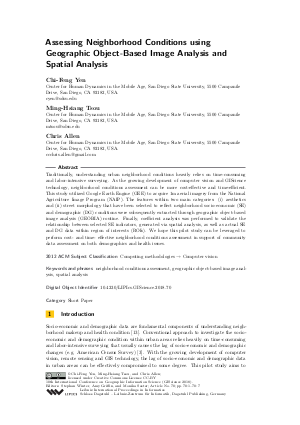Assessing Neighborhood Conditions using Geographic Object-Based Image Analysis and Spatial Analysis (Short Paper)
Authors Chi-Feng Yen, Ming-Hsiang Tsou, Chris Allen
-
Part of:
Volume:
10th International Conference on Geographic Information Science (GIScience 2018)
Part of: Series: Leibniz International Proceedings in Informatics (LIPIcs)
Part of: Conference: International Conference on Geographic Information Science (GIScience) - License:
 Creative Commons Attribution 3.0 Unported license
Creative Commons Attribution 3.0 Unported license
- Publication Date: 2018-08-02
File

PDF
LIPIcs.GISCIENCE.2018.70.pdf
- Filesize: 438 kB
- 7 pages
Document Identifiers
Subject Classification
ACM Subject Classification
- Computing methodologies → Computer vision
Keywords
- neighborhood conditions assessment
- geographic object-based image analysis
- spatial analysis
Metrics
- Access Statistics
-
Total Accesses (updated on a weekly basis)
0PDF Downloads0Metadata Views
Abstract
Traditionally, understanding urban neighborhood conditions heavily relies on time-consuming and labor-intensive surveying. As the growing development of computer vision and GIScience technology, neighborhood conditions assessment can be more cost-effective and time-efficient. This study utilized Google Earth Engine (GEE) to acquire 1m aerial imagery from the National Agriculture Image Program (NAIP). The features within two main categories: (i) aesthetics and (ii) street morphology that have been selected to reflect neighborhood socio-economic (SE) and demographic (DG) conditions were subsequently extracted through geographic object-based image analysis (GEOBIA) routine. Finally, coefficient analysis was performed to validate the relationship between selected SE indicators, generated via spatial analysis, as well as actual SE and DG data within region of interests (ROIs). We hope this pilot study can be leveraged to perform cost- and time- effective neighborhood conditions assessment in support of community data assessment on both demographics and health issues.
Cite As Get BibTex
Chi-Feng Yen, Ming-Hsiang Tsou, and Chris Allen. Assessing Neighborhood Conditions using Geographic Object-Based Image Analysis and Spatial Analysis (Short Paper). In 10th International Conference on Geographic Information Science (GIScience 2018). Leibniz International Proceedings in Informatics (LIPIcs), Volume 114, pp. 70:1-70:7, Schloss Dagstuhl – Leibniz-Zentrum für Informatik (2018)
https://doi.org/10.4230/LIPIcs.GISCIENCE.2018.70
BibTex
@InProceedings{yen_et_al:LIPIcs.GISCIENCE.2018.70,
author = {Yen, Chi-Feng and Tsou, Ming-Hsiang and Allen, Chris},
title = {{Assessing Neighborhood Conditions using Geographic Object-Based Image Analysis and Spatial Analysis}},
booktitle = {10th International Conference on Geographic Information Science (GIScience 2018)},
pages = {70:1--70:7},
series = {Leibniz International Proceedings in Informatics (LIPIcs)},
ISBN = {978-3-95977-083-5},
ISSN = {1868-8969},
year = {2018},
volume = {114},
editor = {Winter, Stephan and Griffin, Amy and Sester, Monika},
publisher = {Schloss Dagstuhl -- Leibniz-Zentrum f{\"u}r Informatik},
address = {Dagstuhl, Germany},
URL = {https://drops.dagstuhl.de/entities/document/10.4230/LIPIcs.GISCIENCE.2018.70},
URN = {urn:nbn:de:0030-drops-93983},
doi = {10.4230/LIPIcs.GISCIENCE.2018.70},
annote = {Keywords: neighborhood conditions assessment, geographic object-based image analysis, spatial analysis}
}
Author Details
- Center for Human Dynamics in the Mobile Age, San Diego State University, 5500 Campanile Drive, San Diego, CA 92182, USA.
- Center for Human Dynamics in the Mobile Age, San Diego State University, 5500 Campanile Drive, San Diego, CA 92182, USA.
References
-
Derek Azar, Ryan Engstrom, Jordan Graesser, and Joshua Comenetz. Generation of fine-scale population layers using multi-resolution satellite imagery and geospatial data. Remote Sensing of Environment, 130:219-232, 2013.

-
Derek Azar, Jordan Graesser, Ryan Engstrom, Joshua Comenetz, Robert M Leddy Jr, Nancy G Schechtman, and Theresa Andrews. Spatial refinement of census population distribution using remotely sensed estimates of impervious surfaces in haiti. International Journal of Remote Sensing, 31(21):5635-5655, 2010.

- Timnit Gebru, Jonathan Krause, Yilun Wang, Duyun Chen, Jia Deng, Erez Lieberman Aiden, and Li Fei-Fei. Using deep learning and google street view to estimate the demographic makeup of neighborhoods across the united states. Proceedings of the National Academy of Sciences, 114(50):13108, 2017. URL: http://www.pnas.org/content/114/50/13108.abstract.
-
Scarlett Lin Gomez, Sally L Glaser, Laura A McClure, Sarah J Shema, Melissa Kealey, Theresa HM Keegan, and William A Satariano. The california neighborhoods data system: a new resource for examining the impact of neighborhood characteristics on cancer incidence and outcomes in populations. Cancer Causes &Control, 22(4):631-647, 2011.

-
Geoffrey J. Hay and G. Castilla. Geographic Object-Based Image Analysis (GEOBIA): A new name for a new discipline, pages 75-89. Springer, 2008.

-
Theresa HM Keegan, Salma Shariff-Marco, Meera Sangaramoorthy, Jocelyn Koo, Andrew Hertz, Clayton W Schupp, Juan Yang, Esther M John, and Scarlett L Gomez. Neighborhood influences on recreational physical activity and survival after breast cancer. Cancer Causes &Control, 25(10):1295-1308, 2014.

- Xiaojiang Li, Chuanrong Zhang, Weidong Li, Yulia A. Kuzovkina, and Daniel Weiner. Who lives in greener neighborhoods? the distribution of street greenery and its association with residents’ socioeconomic conditions in hartford, connecticut, usa. Urban Forestry &Urban Greening, 14(4):751-759, 2015. URL: http://dx.doi.org/10.1016/j.ufug.2015.07.006.
-
D Stow, A Lopez, C Lippitt, S Hinton, and J Weeks. Object‐based classification of residential land use within accra, ghana based on quickbird satellite data. International journal of remote sensing, 28(22):5167-5173, 2007.

-
Douglas Stow. Geographic object-based image change analysis, pages 565-582. Springer, 2010.

-
Douglas A Stow, Christopher D Lippitt, and John R Weeks. Geographic object-based delineation of neighborhoods of accra, ghana using quickbird satellite imagery. Photogrammetric Engineering &Remote Sensing, 76(8):907-914, 2010.

-
Douglas A Stow, John R Weeks, Sory Toure, Lloyd L Coulter, Christopher D Lippitt, and Eric Ashcroft. Urban vegetation cover and vegetation change in accra, ghana: Connection to housing quality. The Professional Geographer, 65(3):451-465, 2013.

-
Francisco J Tapiador, Silvania Avelar, Carlos Tavares-Corrêa, and Rainer Zah. Deriving fine-scale socioeconomic information of urban areas using very high-resolution satellite imagery. International journal of remote sensing, 32(21):6437-6456, 2011.

-
John R Weeks, Arthur Getis, Douglas A Stow, Allan G Hill, David Rain, Ryan Engstrom, Justin Stoler, Christopher Lippitt, Marta Jankowska, and Anna Carla Lopez-Carr. Connecting the dots between health, poverty and place in accra, ghana. Annals of the Association of American Geographers, 102(5):932-941, 2012.

